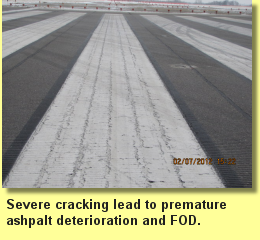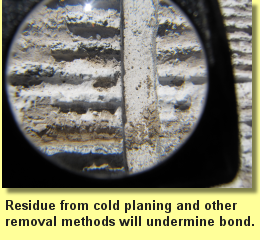 |
 |
Cold Planing MarkingsBy Donna Speidel"Mill and overlay" was my recommendation. If you've ever made this recommendation to an airport, you know it usually isn't followed with enthusiasm or acceptance. This was no exception considering the runway was only seven years old. However, the options were limited. The pavement was distressed, ultrahigh waterblasting wasn't mitigating damage to the surface, and grinding wasn't an option on the grooved asphalt; we needed an innovative solution. Seven months prior, I was hired by a construction engineer to visit an airport to develop solutions for marking rehabilitation on a runway constructed in 2005. When I arrived, I was briefed on the history of this particular project. The original marking specifications for the construction of the grooved asphalt runway were unique, to say the least. First, the markings were to be recessed from the pavement surface. The new asphalt was milled 1/8-inch in the areas to be marked. Second, the coating specified was a durable polyurea applied at 30 wet mils. The polyurea runway markings were installed into the recesses of the pavement in 12-inch wide passes. The expectation was the durable markings would last longer than conventional waterborne paint.
Specifications were developed for the removal of the markings, including multiple methods and degrees of paint removal for different marking/pavement conditions. The recommendation to mill, overlay, groove, and repaint was exclusively for the Threshold Markings in the attempt to eliminate the potential for FOD due to the volume of traffic. The other markings were generally outside of the traffic areas and it was believed ultrahigh waterblasting to an 85-90 percent degree would remove the loose paint and asphalt. Grinding was also a consideration on ungrooved pavements. Test strips with each piece of equipment were recommended prior to wholesale removal to determine the most appropriate method. Among the removal equipment tests, a cold planer produced the least amount of damage to the pavement. Originally developed to remove high spots from uneven pavement surfaces, the cold planing method was able to adequately remove most of the markings and distressed asphalt. Ultrahigh pressure waterblasting removed the Centerlines and Runway Landing Designation Markings where the polyurea had not been orignally applied. Grinders were used to remove the Side Stripes to an 85-90 percent degree outside of the grooved areas. Multiple removal methods used in concert provided the best results on this runway.
The project, like all, was a learning experience. Paint removal is never pretty, but is often necessary when airports paint themselves into a corner and no other options are left. While it may not be conventional, cold planing can be a potential solution in your arsenal when removing markings on distressed pavements. Feel free to share your own unconventional methods with me: email Donna. |

 About a year later, the markings were repainted with waterborne paint due to cracking of the durable coating. Each year after,
the cracking returned, and the airport repainted the markings in preparations for its annual FAA inspection. The result of seven years of
repainting was severe cracking of both the markings and the underlying asphalt surfaces, pictured, right. The main problem was the resulting
FOD from the coating pulling the asphalt apart. All of the markings had been painted this way with exception to the Centerlines and Runway
Landing Designation Markings. The challenge I was brought in to solve was how to remove the markings without further damage to the asphalt.
About a year later, the markings were repainted with waterborne paint due to cracking of the durable coating. Each year after,
the cracking returned, and the airport repainted the markings in preparations for its annual FAA inspection. The result of seven years of
repainting was severe cracking of both the markings and the underlying asphalt surfaces, pictured, right. The main problem was the resulting
FOD from the coating pulling the asphalt apart. All of the markings had been painted this way with exception to the Centerlines and Runway
Landing Designation Markings. The challenge I was brought in to solve was how to remove the markings without further damage to the asphalt.
 The areas that were cold planed had to be regrooved and repainted. Cold planing, grinding, and even waterblasting can leave a
fine slurry or residue in the areas to be restriped. In the interest of doing it right the first time, surface preparation was performed to
thoroughly flush any contaminants that might undermine the bond between paint and pavement. Once clean, a primer coat (read the article
The areas that were cold planed had to be regrooved and repainted. Cold planing, grinding, and even waterblasting can leave a
fine slurry or residue in the areas to be restriped. In the interest of doing it right the first time, surface preparation was performed to
thoroughly flush any contaminants that might undermine the bond between paint and pavement. Once clean, a primer coat (read the article